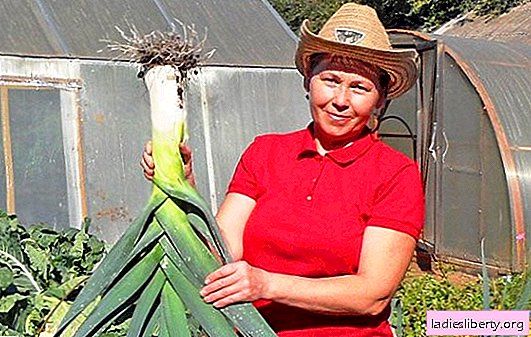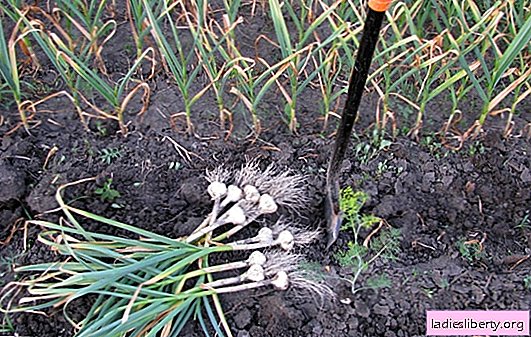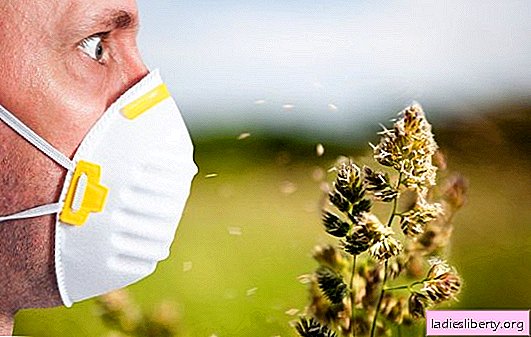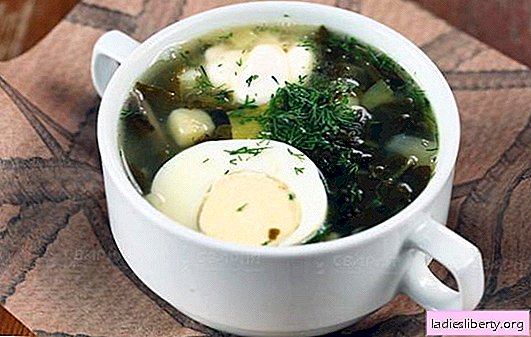
Leek is very useful and versatile, it is eaten fresh and prepared. They grow onions everywhere, this is a rather unpretentious culture, which is rich in vitamin C. In cooking, not only greens are used, but also "legs" - bleached falsely stems. The cultivation process is not laborious, even an aspiring gardener can do it.
Leek: planting seeds for seedlings
The vegetation period of this culture is quite long, so onions should be planted in seedlings. There are some principles to consider when sowing seeds:
• Soak planting material in warm water for approximately 25 minutes. Further, the seeds are left wrapped in a damp cloth for several days. This should be done regardless of the method of growing, the procedure accelerates the emergence of seedlings.
• Sowing seeds for seedlings should be carried out not earlier than the beginning of March.
• Soil for seedlings is prepared in advance. As a soil mixture use turf land with humus or peat.
• The distance between the lines in the container should be no more than 5 cm, and the depth of seed placement - about 1 cm.
• Boxes with seeds must be covered with a film to maintain the necessary level of humidity and heat.
• When shoots appear, the daytime temperature should be about 18 degrees, the nighttime temperature should be 10 degrees.
• Seedlings need top dressing, which is carried out twice using mineral fertilizers.
• Regular watering of seedlings is the key to growing strong and healthy seedlings.
Before planting leek seedlings on a bed, it must be hardened. To do this, a week before the proposed planting, the temperature in the room is reduced, containers with seedlings are taken out into the open air.
Planting onion seedlings in the garden
About two months old seedlings are planted on the beds. This should be done no earlier than the beginning of May. At this point, the plants should be strong, have a well-developed root system, two pairs of leaves and reach a height of about 15 cm.

To grow leeks, you need to select well-lit areas, as he prefers heat and light. In the shade, the plant will feel bad, yield will decrease, and the risk of disease will increase.
The soil before planting needs to be well fertilized. For 1 square. m. beds use 2 tbsp. l mineral fertilizers, a bucket of humus mixed with 2 glasses of ash. The earth is well dug and moistened.
The scheme of planting leeks on the beds is two-line. The distance between the plants in the row is 10-15 cm, and between the lines about 30 cm. The depth of rooting of the leek roots is 15-20 cm.

Unfinished seedlings are covered with a spanbond until warm weather is established and night frosts go away.
We grow leek: plant care (photo)
In order for the onion crop to be good, and the taste to be excellent, you need to follow the agricultural technology of cultivation and the rules for caring for the plant.
The plant is demanding care at the very beginning of the growing season, and after planting in the ground, then, the process is simplified.
1. The most important factor in growing leeks is the absence of weeds in the garden. Weeding should be carried out in a timely manner.
2. The soil should always be in a wet state, but this means that you need to arrange a swamp in the garden. Moderate humidity is another component on the way to a good harvest. It is necessary to increase the amount of watering in June, when the green mass is formed, and also in July, when the bulb is formed.
3. To get a good white leg, the plant needs to be spud several times a season. After this, the soil around should be well mulched with straw or mowed grass.

4. A few weeks after transplanting, the plant is fed. To do this, use bird droppings or mullein. The solution is watered with a row-spacing; pouring liquid on the plant itself is impossible. On good nutrient soils, you can do with the infusion of fermented grass.
5. When feeding plants, you need to monitor the nitrogen content in the mixtures. An excess of it leads to the decay of onions, even during storage.
Important! Before hilling onions, a little bit of ash can be added under each plant.
Harvesting onions for storage
Harvest the onion as necessary. In late autumn, all plants should be stored. All plants selected for long-term storage should be prepared. Each bulb is examined: damaged leaves are removed, the remaining are cut to 1/3 of the length, the roots are also cut, leaving about 1 cm.
It stores onions at a temperature of about 2-5 degrees. The cellar or the lower chamber of the refrigerator will do.
• When storing onions in the refrigerator, you need to wrap it in film, then it will lie much longer without losing its qualities.
• In the cellar, onions are stored only in an upright position, in wet sand. To backfill onions, you can use the soil from the beds.

Important! Leek does not stop growing, even when put away for storage.
If there is not enough space to store fresh onions, it can be dried. To do this, clean the white leg, cut and dried in the room, then in the oven. You need to store such a blank in a linen bag, a cardboard box, but not in a hermetically sealed container.
Leek: Growing Tips
1. In the southern regions of the country, you can grow leeks by sowing seeds directly into the ground. The optimal time for sowing is the beginning of March, which can be continued in April. Timing depends on the weather and plant variety. Seeds are sown in rows, the distance between which should be about 60 cm. When several leaves appear at the seedlings, the plants are thinned out. Repeat the procedure when two pairs of leaves appear. After the last thinning, the distance between plants should be at least 10-15 cm.
2. If the daily temperature is kept below 15 degrees, then watering is not carried out. The drip irrigation system will help to adjust the frequency of watering and evenly distribute moisture. It allows you to accurately dose the nutrient mixture, feeding fertilizer in the amount that is necessary for each plant.
3. Irrigation by irrigation is not very effective, since the risk of spreading diseases increases due to increased air humidity.
4. Tomatoes, cucumbers, potatoes, cabbage, perennial herbs will be good predecessors for growing leeks. After this crop, you can also plant almost all vegetables.
For the secondary planting of onions, you need to choose a garden where suitable crops used to grow. Leek can only be returned to its original place after 4 years. An earlier landing entails an increase in the number of pests and diseases.
Leek: diseases and pests (photo)
With proper care, the plant does not practically bleach and is not damaged by pests. But neglected landings are often attacked by various parasites.
• Onion fly - the most treacherous enemy that eats leaves. The pest larvae eat up the white leg, the crop can be thrown away. For prevention, you can plant leeks next to carrots.

• Viral mosaic infects plants after a dive. Yellow spots appear on the leaves that prevent the onion from developing. For planting, you need to use only fresh onion seeds.
Important! Growing leek after garlic is not recommended! These plants are close relatives.











